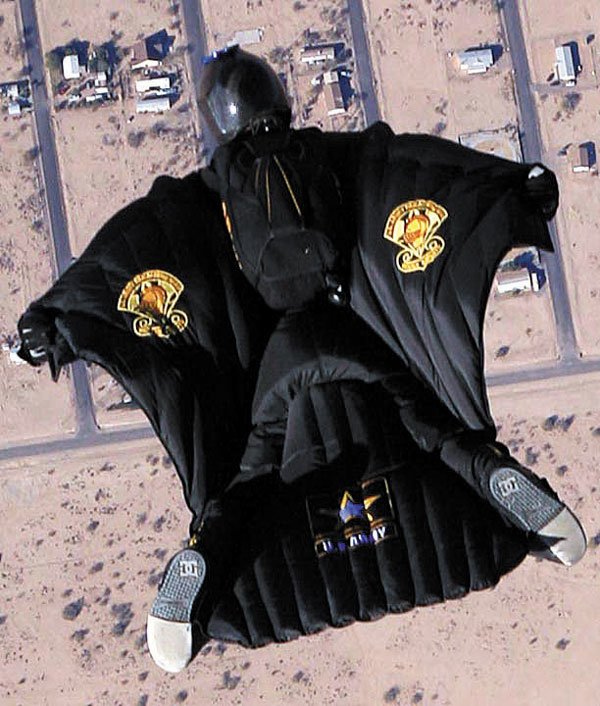Dressed in a suit that bears a striking resemblance to a flying
squirrel, Army Staff Sgt. Ben Borger leapt from a jet flying six
miles in the sky, catching air long enough to break the world
record for longest distance flown in a wing suit.
Dressed in a suit that bears a striking resemblance to a flying squirrel, Army Staff Sgt. Ben Borger leapt from a jet flying six miles in the sky, catching air long enough to break the world record for longest distance flown in a wing suit.
With nearly 3,000 jumps under his belt, the 27-year-old Gilroy High School graduate made his most recent skydive count. The five-year member of the U.S. Army Golden Knights Parachute Team soared for 11.5 miles, breaking the previous record of 10 miles, before landing in a field somewhere near Altus, Okla., on Wednesday. In addition to his wing suit, an oxygen mask and several layers of gear, Borger touched down with a smile that didn’t leave his face for days.
“There he was, a world record holder,” said Sgt. First Class Will Flemming, Borger’s team leader who was waiting on the ground when Borger took the plunge. “He was happy. After every jump, you can’t do anything but smile anyway.”
It’s fitting that Borger would break the world record, Flemming said.
“I’ve never known him to accept anything less than the best,” he said.
Even before he had graduated from GHS in 2002, Borger had signed up for the Army.
“I joined the Army for adventure,” he said. “I’m an outdoorsy person. But (skydiving) wasn’t an intended career. It was something I stumbled upon.”
After a year-long tour in Iraq, Borger returned to the States and started skydiving recreationally. These days, he performs 260 days a year at sporting events and air shows as part of the Golden Knights Parachute Team. When he wasn’t performing with his team, he got hooked on experimenting with a wing suit for his jumps. After adding two miles, then five, then six miles to his jumps’ horizontal distances, he started preparing to break the world record. A year of planning and countless hours spent researching later, Borger was ready for the big day.
Borger started off his morning around 3 a.m. April 14. After meeting with his team and preparing the plane for the adventure, he sat down for an hour to breathe pure oxygen to flush his blood of any nitrogen, which could cause decompression sickness – commonly known as the bends.
With a crew of less than 10 men, he boarded the cavernous C-17 aircraft, also known as a Globemaster, which is built to hold more than 100 paratroopers or haul military vehicles, such as helicopters or tanks. A smaller plane would have taken longer to make the six-mile ascent, posing the risk of oxygen deprivation, he explained. If crew members took off their oxygen masks, they would have remained conscious for less than a minute before passing out, Borger said.
Six minutes before the jump, the C-17’s tailgate began lowering, and Borger received a blast of negative 45-degree air.
“It was kind of surreal,” he said. “As I looked out, I could see the contrails coming off the plane and feel the rush of cold air. I remember thinking, ‘OK, this is gonna be a bit chilly.'”
At that altitude, exposed skin means guaranteed frostbite, so Borger dressed carefully that morning, layering on three pairs of gloves and plenty of cold-weather gear.
“I didn’t want to be bundled up like (Randy) from “A Christmas Story,” he laughed. “So I had to research about what was going to keep me warm but keep me flexible.”
With nearly 3,000 jumps under his belt, the rush of adrenaline mixed with a dash of nerves that washed over Borger was a familiar friend.
“I do get nervous, but it’s a good nervous,” he said.
At T-minus 30 seconds, Borger stepped to the edge of the platform, watching as the jet streaked a white trail of condensation against the blue sky. With only moments to go, he watched as one of the crewmen ticked off the remaining 10 seconds on his fingers. After folding down his last finger, the crew member pointed at Borger, who leapt off the platform into the sub-zero degree air and toward his world record.
“It was really no different from any other skydive, just a little bit colder and with a little less oxygen,” he said. “And in a wing suit, you don’t get the same sensation of falling with the wind rushing past as you do with a normal skydive.”
Instead of plummeting to the ground, Borger’s “wings” caught the draft and lifted him above the plane, nearly six and a quarter miles above the ground.
With a forward speed of about 110 mph, Borger knifed through the sky in free fall for six minutes and 35 seconds before pulling his chute. A normal skydive – which takes place at 12,000 feet, not 32,000 feet – usually allows for only about 45 seconds of free fall.
He touched down in a field a little off course but knowing he had broken the record.
To celebrate, he took a long nap after the physically exhausting morning, he said, laughing at the memory.
“You know, it gave me a lot of job satisfaction,” he said. “I’m doing something I love.”
Anxious to hear from their son, Borger’s parents breathed an excited sigh of relief after hearing both pieces of good news: Their son landed safely and broke the world record.
“We always joke about why someone would want to jump out of a perfectly functioning plane,” Roger Borger joked. “But I’m very proud of him.”
Ever since his son was little, Roger Borger remembered him gravitating toward the Army.
“I remember driving down El Camino Real, Ben always wanted to go into the Army surplus store,” Roger Borger said.
Signing up for the Army after graduation just seemed to make sense, he said.
“He’s accomplished so much,” said Anita Borger, who has skydived twice with her son. “For Ben, there’s no such thing as an eight hour day, and that’s the way it is with everything. He feels there is so much to do and not enough time.”














